Our drawing, recently rediscovered for the thin corpus of an artist who died prematurely, is very likely a portrait of his daughter. Indeed, we find this young and familiar model several times in Vidal's work. The particular shape of the face, the pointed chin, the haircut according to age are indeed characteristics common to several portraits:
- The full-length one, with the red dress, sold at Christie's, London, July 13, 2017, lot 122
- The one in bust, with the black hat, Sotheby's, London, November 5, 1998, lot 56
- And finally, the one kept at the Musée du Petit Palais, made a few years later, pastel titled "Ernestine", on which our model bears a red scarf. (Inv. PPD3560
OUR PORTRAIT
It stands out for its use of charcoal, a less commercial medium than pastel and oil, but which revealed Vidal as a great artist when he exhibited with the masters of impressionism, then at the Salon des French artists. Here the technical mastery is particularly remarkable. The light coming from the window hits this meditative young girl from the right side.
She emphasizes the face and the hands. The left abandons itself, hanging from the back of the chair , the left still holds the abandoned book. The artist immortalizes this singular moment of a mind absorbed in reflection, This intimate moment which sees the mind escape and the body remain. This absence/presence antagonism gives this portrait his strength and his poetry. There is no smile or coquetry, although they are common on Vidal's faces. This charcoal announces the transition to the last phase of the artist's production, more marked by symbolism.
The aesthetic of our drawing evokes also the modern paragon which contrasts or compares late 19th century photography and pencil portraits. Our portrait, with an aesthetic close to pictorialist creations, is also intended to be a demonstration of the superiority of drawing, and its capacity to imitate, compete with, and surpass photography.
One of the arguments of this demonstration is the use of bold, rich materials, both charcoal and chalk, abundantly on kraft-colored paper, testifying to the artist's pleasure in putting the image of his work on paper. girl. We think we can see in the background, as in the portrait with the red dress, the sea at Cagnes, where the artist, like Renoir, bought a house.
VIDAL
A former student of Gérome, Vidal began his career in 1873 at the Salon, with a charcoal portrait. Friend of Degas who praised his talents as a portraitist, he participated twice in impressionist exhibitions. He won a medal at the Universal Exhibition of 1900. The Fine Arts museums of Paris, Lille and Tours hold works by the artist. Note, to complete the family portrait, the portrait of Madame Vidal kept at the Quimper Museum. (Inv. 55-56) Friend of Colette, Marie-Léonie, née Devoir, published under the pen name Henry de Lucenay.





































 Le Magazine de PROANTIC
Le Magazine de PROANTIC TRÉSORS Magazine
TRÉSORS Magazine Rivista Artiquariato
Rivista Artiquariato